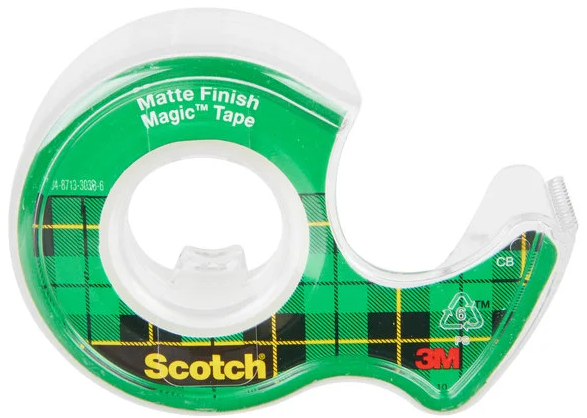The Derogatory Term in Your Junk Drawer

Pictured above is a junk drawer. It’s not my junk drawer — it’s one that the Container Store (a store that sells containers) features on its website, in an article titled “How To Organize A Junk Drawer.” But it’s close enough for our purposes, as many of the items in the junk drawer above can be found in most junk drawers. There’s a cheap calculator, a roll of Scotch tape, a pair of scissors, two flashlights, a bunch of batteries, at least one screwdriver, sunglasses, some pills, a padlock, lots of random wires, a hair elastic, and even a toy car. There’s nothing even remotely offensive about it, except perhaps by how disorganized it is, but really, who are any of us to judge? Junk drawers are where not-immediately-needed but otherwise useful stuff lives; we tend to tolerate the disorder.
And we also tolerate a bit of bigotry, too. But you probably didn’t know it. The culprit? This guy.

Yes, Scotch tape. Very useful in a number of situations. But also, probably not the most nicely-named item you own.
Scotch tape is a name-brand for a bunch of types of tape manufactured by 3M. (Even 3M’s masking tapes carry the “Scotch” brand, as seen here.) But in everyday parlance, we’ve made the term into a generic one; “Scotch tape” is synonymous with “clear, adhesive tape,” whether it’s made by 3M or otherwise. And, despite the name and the tartan design on the packaging, it has nothing to do with Scotland.
If you go to 3M’s official website, you’ll find very little about the history of the product; the page states that “Richard Drew, a young 3M engineer, invents Scotch® Cellulose Tape. Later to be renamed Cellophane Tape, it is an attractive, moisture-proof way for grocers and bakers to seal packages. The tape helps people “make do” during the Great Depression—they made simple repairs to household items.” Directly below that, in an image, it describes Drew as a “young banjo player-turned-3M engineer” and notes that the tape’s first purpose was “to serve as a moisture-proof seal for the cellophane food packaging then coming into vogue.” There’s nothing about the Scotch branding, and there’s no reason to think Drew was, himself, of Scottish ancestry. 3M itself isn’t particularly Scottish, either; the corporation, per its corporate history page, “started as a small-scale mining venture in Northern Minnesota, then named Minnesota Mining and Manufacturing Company.”
The 3M comes from the first letters of the first words of that company. But where does the Scotch name come from?
Most likely, from some frustrated auto workers.
As Smithsonian reports, Drew got his start with 3M in a different line of business, making deliveries to autobody shops. Per Smithsonian, “in the 1920s, two-tone cars were trendy. Workers needed to mask off part of the car while they painted the other, and often used glued-on newspaper or butcher paper for the job. But that was difficult to get off, and often resulted in a sticky mess.” Drew, per the American Chemical Society, heard the workers using the “choicest profanity I’d ever known,” and decided to do something about it. Even though he had very little experience with materials engineering — he had dropped out of engineering school — he began searching for a solution. Two years later, he came up with a tape that, per Smithsonian, “was sticky yet easy to remove.” He returned to the autobody shop with his invention in hand, which was probably more akin to today’s masking tape than the clear tape we call Scotch today. But in any event, it didn’t quite work. When the painters applied the tape, it stuck for a bit, but then fell off on its own.
The problem wasn’t the adhesive that Drew developed, though — it was the amount he used. Drew’s original tape only had the glue on the edges of the film; the middle of it was left alone. More of the sticky stuff would probably solve the issue, and the automobile painters let Drew know it. As Gizmodo relays, “one version of the story claims that the painter asked, ‘Why so Scotch with the adhesive?’ Another version states that the painter said ‘Take this back to your Scotch bosses and tell them to put more adhesive on it.'” Scotch, at the time, was a pejorative word for someone who is stingy, a reference to an anti-Scottish stereotype at the time.
Drew and 3M apparently didn’t mind the insult — they added more adhesive to the tape, just like the painter suggested. And for whatever reason — perhaps to drive home that the tape was an inexpensive solution to many problems, which was particularly important during the Great Depression — 3M adopted the slur as the brand name for the tape. By the late 1950s, the pejorative use of the word “Scotch” had fallen out of our collective vernacular, and 3M hasn’t seemed interested in revisiting the name since.
Bonus fact: Scotch tape isn’t Scotch, and for that matter, neither are Scotch eggs. It’s probably just a misspelling that got carried forward and capitalized. As the Edinburgh Tourist reports, “A traditional Scotch Egg is a boiled egg coated in pork sausage meat, with an outer crust of breadcrumbs. The deep-fried snack is called a Scotch Egg because the process of mincing the meat to go around the egg is known as scorching,” which is close enough to the word “Scotch” to cause confusion. Similarly, per Etymology Online, using the term “Scotch” to mean “to cut, score, gash, make an incision” is an uncommon but not unheard of use, and historically, probably just a misspelling of “scratch.”
From the Archives: The Tool That’s Made to Be Broken: Say hi to your tape measure.
